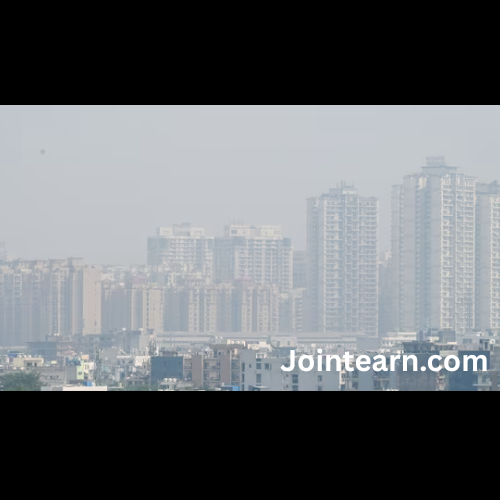
After a brief respite over the past few days, the air quality in Delhi has again deteriorated sharply, plunging into the ‘very poor’ category on Sunday morning. Several parts of the city recorded AQI levels approaching ‘severe,’ reversing the slight improvement seen in the aftermath of Diwali celebrations.
On Friday and Saturday, the city had registered AQI levels of 275 and 292, respectively, keeping the air in the ‘poor’ category. These readings had come down slightly from the post-Diwali spike, giving residents a temporary relief from thick smog. However, on Sunday, the situation worsened significantly. Thick haze enveloped the city as early as the morning hours, affecting visibility in many areas and creating an unhealthy environment for residents commuting to work or stepping out for morning activities.
According to data from the Central Pollution Control Board (CPCB), Anand Vihar recorded the highest pollution levels with an AQI of 430, categorizing the air quality as ‘severe.’ Wazirpur also fell into the severe range, recording an AQI of 403. In contrast, the least polluted area was Najafgarh, which had an AQI of 164, placing it in the ‘moderate’ category, followed by Sri Aurobindo Marg at 176.
Across 39 monitoring stations in Delhi, 26 reported air quality in the ‘very poor’ range (301–400), while seven stations recorded air quality in the ‘poor’ category (201–300). Areas experiencing very poor air quality included Alipur, ITO, Jahangirpuri, Rohini, and several others. Only a few pockets of the city showed marginally better conditions, but no area reported air quality in the ‘good’ or ‘satisfactory’ ranges.
Understanding AQI and Its Implications
The Air Quality Index (AQI) is a standardized measure of pollution levels and their potential health impact. According to CPCB, an AQI between 0–50 is considered ‘good,’ 51–100 ‘satisfactory,’ 101–200 ‘moderate,’ 201–300 ‘poor,’ 301–400 ‘very poor,’ and 401–500 ‘severe.’ Higher AQI levels indicate the presence of harmful pollutants in the air, including particulate matter (PM2.5 and PM10), nitrogen dioxide, sulfur dioxide, and carbon monoxide.
Health experts have warned residents about the acute effects of such high pollution levels. Former AIIMS Director, Dr. Randeep Guleria, advised citizens to take precautionary measures to minimize exposure to polluted air. “The current high levels of air pollution are causing significant health issues, especially for the elderly, young children, and people with pre-existing heart or lung conditions. Symptoms include chest discomfort, breathing difficulties, coughing, and aggravation of asthma or COPD,” he said.
Even healthy individuals are not immune. Dr. Guleria noted that many residents reported nasal congestion, throat irritation, chest tightness, and persistent coughing. He attributed these effects to inflammation and narrowing of the airways caused by pollutants. He further mentioned that despite the use of green firecrackers during Diwali, the festivities contributed to worsening air quality in the city.
AQI Levels Across Delhi (as of 7 AM Sunday)
- Anand Vihar – 430 (Severe)
- Wazirpur – 403 (Severe)
- Rohini – 362 (Very Poor)
- Ashok Vihar – 369 (Very Poor)
- Alipur – 309 (Very Poor)
- Bawana – 390 (Very Poor)
- Burari Crossing – 344 (Very Poor)
- CRRI Mathura Road – 330 (Very Poor)
- Chandni Chowk – 376 (Very Poor)
- DTU – 266 (Poor)
- Dr. Karni Singh Shooting Range – 317 (Very Poor)
- Dwarka Sector-8 – 301 (Very Poor)
- IGI Airport (T3) – 269 (Poor)
- IHBAS, Dilshad Garden – 310 (Very Poor)
- ITO – 329 (Very Poor)
- Jahangirpuri – 370 (Very Poor)
- Jawaharlal Nehru Stadium – 304 (Very Poor)
- Lodhi Road (DPCC) – 283 (Poor)
- Lodhi Road (IMD) – 290 (Poor)
- Major Dhyan Chand National Stadium – 306 (Very Poor)
- Mandir Marg – 312 (Very Poor)
- Mundka – 356 (Very Poor)
- NSIT Dwarka – 285 (Poor)
- Najafgarh – 164 (Moderate)
- Narela – 338 (Very Poor)
- Nehru Nagar – 339 (Very Poor)
- North Campus, DU – 321 (Very Poor)
- Okhla Phase-2 – 324 (Very Poor)
- Patparganj – 339 (Very Poor)
- Punjabi Bagh – 353 (Very Poor)
- Pusa (DPCC) – 314 (Very Poor)
- Pusa (IMD) – 309 (Very Poor)
- R K Puram – 324 (Very Poor)
- Shadipur – 334 (Very Poor)
- Sirifort – 322 (Very Poor)
- Sonia Vihar – 330 (Very Poor)
- Sri Aurobindo Marg – 176 (Moderate)
- Vivek Vihar – 371 (Very Poor)
Preventive Measures for Residents
Authorities and health experts advise people to limit outdoor activities, especially in the early morning and late evening when pollution tends to peak. The use of masks designed to filter fine particulate matter, maintaining indoor air quality through air purifiers, and avoiding strenuous exercise outdoors are recommended for all residents. Vulnerable groups such as children, the elderly, and individuals with respiratory or cardiac conditions should take extra precautions.
As Delhi grapples with rising pollution, officials continue to monitor air quality across the city and provide real-time updates through the CPCB and Delhi Pollution Control Committee (DPCC) platforms. Citizens are urged to stay informed and take all necessary protective measures until the air quality improves.
The worsening of Delhi’s air quality highlights the ongoing challenges faced by the capital in mitigating pollution, especially in the post-Diwali period when festival-related emissions combine with vehicular and industrial pollutants to create hazardous conditions.
Leave a Reply